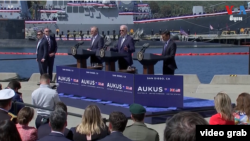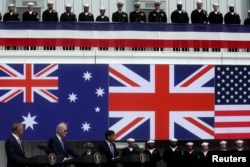On June 6, the United States dismissed Cambodian Prime Minister Hun Sen’s accusations of nuclear proliferation against the trilateral security alliance between Australia, the United Kingdom and the United States.
This security alliance, announced in September 2021 and known as AUKUS, will support Australia’s navy in acquiring nuclear-powered submarines to counter China’s rapid military expansion in the Indo-Pacific region.
Hun Sen said on June 5 that AUKUS is “the starting point of a very dangerous arms race” that will lead to nuclear-powered submarines coming to the region.
Chinese Foreign Ministry spokesperson Wang Wenbin echoed that statement the following day, saying Hun Sen’s remarks expressed concerns widely shared by regional countries:
“According to estimates by international arms control experts, the weapons-grade nuclear materials the U.S. and the U.K. plan to transfer to Australia would be sufficient to build as many as 64 to 80 nuclear weapons.”
That estimate is unsubstantiated.
When Wang cited “international arms control experts,” he was, in fact, referring to two Chinese nuclear research think tanks with ties to the Chinese government.
The China Arms Control and Disarmament Association is an NGO directly managed by the Chinese Ministry of Foreign Affairs. The China Institute of Nuclear Industry Strategy is a subsidiary of the China National Nuclear Corporation, a state-owned enterprise.
Wang cited data estimates from a report the two think tanks produced in 2022, titled “A Dangerous Conspiracy: The Nuclear Proliferation Risk of the Nuclear-powered Submarines Collaboration in the Context of AUKUS.”
That report berated Australia, the U.S. and the U.K. for what it said was setting a dangerous precedent with AUKUS that would allow nuclear states to transfer weapons-grade nuclear materials to a non-nuclear state for the first time.
It stated:
“[T]he eight nuclear submarines will need a total of 1.6 to 2 tons of weapons-grade HEU3. As 25 kilograms of weapons-grade HEU [highly enriched uranium] is needed to make one nuclear weapon4, the weapons-grade nuclear materials to be transferred to Australia by the other two countries would be sufficient to build as many as 64 to 80 nuclear weapons.”
However, according to Pavel Podvig, a senior researcher in the weapons of mass destruction program at the United Nations Institute for Disarmament, that estimate by the two Chinese think tanks was based on two assumptions.
The first was that Australia would receive eight submarines under the AUKUS deal. The second was that the reactors on those submarines would contain between 1.6 and 2 tons of HEU. There is no data verifying any of those assumptions.
So far, the AUKUS plan is for Australia to purchase three submarines from the U.S. in the early 2030s, with an option to buy two more later.
As for HEU, the amount of HEU used in reactors on such submarines is unknown, and “one of the secrets that are heavily guarded,” according to Podvig.
Another factor complicating the estimate is that Australia will not receive HEU in the form of material. AUKUS members made it clear that the reactors will be sealed inside the submarine hulls and Australia will not have access to the fuel in the reactors throughout the lifetime of the submarines.
Jeffrey Lewis, director of the East Asia Nonproliferation Program at the Middlebury Institute of International Studies at Monterey, in Monterey, California, said the idea that Australia would build nuclear weapons through this process is “absurd.”
Lewis noted that for Australia to use the welded nuclear reactor core to build a nuclear weapon, it would have to open the sealed core, which is unlikely. Once the reactor starts operating, the material will be extremely radioactive and it would be difficult to use it for a nuclear weapon, he added.
“If Australia wanted to build a nuclear weapon, there are much easier ways to do it,” Lewis told VOA’s Polygraph.info.
Still, the AUKUS initiative does make arms controls experts nervous because it sets a precedent for states like Iran to use naval nuclear propulsion as an excuse to manufacture their own highly enriched uranium.
AUKUS utilizes a loophole in the 1968 Nuclear Non-Proliferation Treaty (NPT), which exempts fissile material utilized for “non-explosive military use from inspections and monitoring by the International Atomic Energy Agency (IAEA), the U.N. nuclear watchdog.






